Illinois Central Railroad
 | |
|
Combined route map of the Chicago Central (red) and Illinois Central (blue) railroads in 1996.[1] | |
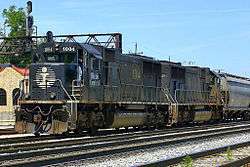 Two Illinois Central EMD SD70's leading a train at Homewood, Illinois | |
| Reporting mark | IC |
|---|---|
| Locale | Midwestern to Gulf Coast, United States |
| Dates of operation | 1851–1999 |
| Successor | Canadian National Railway |
| Track gauge | 4 ft 8 1⁄2 in (1,435 mm) standard gauge |
| Length | 3,130.21 mi (5,037.58 km) |
| Headquarters | Chicago, Illinois |
The Illinois Central Railroad (reporting mark IC), sometimes called the Main Line of Mid-America, was a railroad in the central United States, with its primary routes connecting Chicago, Illinois, with New Orleans, Louisiana, and Mobile, Alabama. A line also connected Chicago with Sioux City, Iowa (1870). There was a significant branch to Omaha, Nebraska (1899), west of Fort Dodge, Iowa, and another branch reaching Sioux Falls, South Dakota (1877), starting from Cherokee, Iowa. The Sioux Falls branch has been abandoned in its entirety.
The Canadian National Railway acquired control of the IC in 1998.
History
Riding on the City of New Orleans
– Steve Goodman, "City of New Orleans", 1970
Illinois Central Monday morning rail
Fifteen cars and fifteen restless riders
Three conductors and 25 sacks of mail...
Good morning America, how are you?
Say, don't you know me? I'm your native son.
The IC is one of the early Class I railroads in the US. Its roots go back to abortive attempts by the Illinois General Assembly to charter a railroad linking the northern and southern parts of the state of Illinois. In 1850 U.S. President Millard Fillmore signed a land grant for the construction of the railroad, making the Illinois Central the first land-grant railroad in the United States.
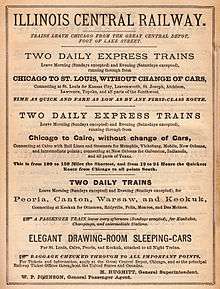
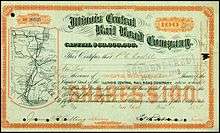
The Illinois Central was chartered by the Illinois General Assembly on February 10, 1851.[2] Senator Stephen Douglas and later President Abraham Lincoln were both Illinois Central men who lobbied for it. Douglas owned land near the terminal in Chicago. Lincoln was a lawyer for the railroad. Upon its completion in 1856 the IC was the longest railroad in the world. Its main line went from Cairo, Illinois, at the southern tip of the state, to Galena, in the northwest corner. A branch line went from Centralia, (named for the railroad) to the rapidly growing city of Chicago. In Chicago its tracks were laid along the shore of Lake Michigan and on an offshore causeway downtown, but land-filling and natural deposition have moved the present-day shore to the east.
In 1867 the Illinois Central extended its track into Iowa, and during the 1870s and 1880s the IC acquired and expanded railroads in the southern United States. IC lines crisscrossed the state of Mississippi and went as far as New Orleans, Louisiana, to the south and Louisville, Kentucky, in the east. In the 1880s, northern lines were built to Dodgeville, Wisconsin, Sioux Falls, South Dakota, and Omaha, Nebraska. Further expansion continued into the early twentieth century.
The Illinois Central, and the other "Harriman lines" owned by E.H. Harriman, was the target of the Illinois Central shopmen's strike of 1911. Although marked by violence and sabotage in the south, midwest, and western states, the strike was effectively over in a few months. The railroads simply hired replacements and withstood diminishing union pressure. The strike was eventually called off in 1915.
| IC (incl Y&MV, G&SI) | Vicksburg Shreveport & Pacific Railroad | Alabama & Vicksburg | |
|---|---|---|---|
| 1925 | 15,050 | 239 | 159 |
| 1933 | 7,776 | (into Y&MV) | (into Y&MV) |
| 1944 | 24,012 | ||
| 1960 | 17,171 | ||
| 1970 | 22,902 |
| IC (incl Y&MV, G&SI) | Vicksburg Shreveport & Pacific | Alabama & Vicksburg | |
|---|---|---|---|
| 1925 | 982 | 22 | 20 |
| 1933 | 547 | (into Y&MV) | (into Y&MV) |
| 1944 | 2225 | ||
| 1960 | 848 | ||
| 1970 | 764 |
The totals above do not include the Waterloo RR, Batesville Southwestern, Peabody Short Line or CofG and its subsidiaries. On December 31, 1925 IC/Y&MV/G&SI operated 6,562 route-miles on 11,030 miles of track; A&V and VS&P added 330 route-miles and 491 track-miles. At the end of 1970 IC operated 6,761 miles of road and 11,159 of track.
Illinois Central Gulf Railroad (1972–1988)

On August 10, 1972, the Illinois Central Railroad merged with the Gulf, Mobile and Ohio Railroad to form the Illinois Central Gulf Railroad (reporting mark ICG). On October 30 that year the Illinois Central Gulf commuter rail crash, the company's deadliest, occurred.
At the end of 1980 ICG operated 8,366 miles of railroad on 13,532 miles of track; that year it reported 33,276 million ton-miles of revenue freight and 323 million passenger-miles. Later in that decade, the railroad spun off most of its east-west lines and many of its redundant north-south lines, including much of the former GM&O. Most of these lines were bought by other railroads, including entirely new railroads such as the Chicago, Missouri and Western Railway, Paducah and Louisville Railway, Chicago Central and Pacific Railroad and MidSouth Rail Corporation.
In 1988 the railroad's then-parent company IC Industries spun off its remaining rail assets and changed its name to the Whitman Corporation (which became PepsiAmericas in 2000 and was acquired outright by PepsiCo in 2010). On February 29, 1988, the newly separated ICG dropped the "Gulf" from its name and again became the Illinois Central Railroad.
Canadian National Railway (1998–present)
On February 11, 1998 the IC was purchased for approximately $2.4 billion in cash and shares by Canadian National Railway (CN). Integration of operations began July 1, 1999.
Locomotives
 An undated photo of Illinois Central RR Locomotive No. 484.
An undated photo of Illinois Central RR Locomotive No. 484.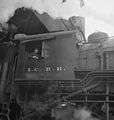 IC steam locomotive, photo taken in November, 1942
IC steam locomotive, photo taken in November, 1942- IC locomotive No.6000, EMD SD40-2R(Ex-SD40) just outside Schoolcraft, MI, waiting on a north bound CN freight train.
 Just outside Schoolcraft, MI, IC locomotive No.9636, a GP38-2, going northbound to Battle Creek.
Just outside Schoolcraft, MI, IC locomotive No.9636, a GP38-2, going northbound to Battle Creek.- IC locomotive No.9612, still in Canadian National livery, sitting in a siding with about 6 cars coupled to it in Pavilion, MI, on June 18, 2008.
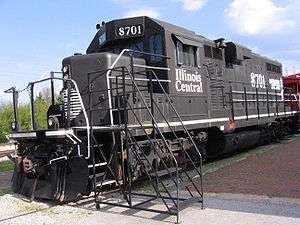 A preserved Illinois Central GP11 locomotive on static display in downtown Carbondale, Illinois.
A preserved Illinois Central GP11 locomotive on static display in downtown Carbondale, Illinois. Canadian National 6226 and Illinois Central 3102 idling at Dubuque, Iowa
Canadian National 6226 and Illinois Central 3102 idling at Dubuque, Iowa
Passenger train service

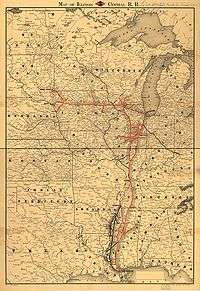
The Illinois Central was a major carrier of passengers on its Chicago to New Orleans mainline and between Chicago and St. Louis. IC also ran passengers on its Chicago to Omaha line, though it was never among the top performers on this route. Illinois Central's largest passenger terminal, Central Station, stood at 12th Street east of Michigan Avenue in Chicago. Due to the railroad's north-south route from the Gulf of Mexico to the Great Lakes, Illinois Central passenger trains were one means of transport during the African American Great Migration of the 1920s.
Illinois Central's most famous train was the Panama Limited, a premier all-Pullman car service between Chicago, St. Louis, Missouri, and New Orleans. In 1967, due to losses incurred by the operation of the train, the Illinois Central combined the Panama Limited with a coach-only train called the Magnolia Star.
On May 1, 1971 Amtrak took over the operation of the service, but shortly afterward dropped the name in favor of the City of New Orleans, a daytime streamlined coach train that had been operated by the Illinois Central whose name was popularized by a song written by Steve Goodman and performed by Arlo Guthrie: Willie Nelson's recording of the song was #1 in 1984.
Illinois Central ran several other trains along the main route including The Creole and The Louisiane.
The Green Diamond was the Illinois Central's premier train between Chicago, Springfield and St. Louis. Other important trains included the Hawkeye which ran daily between Chicago and Sioux City and the City of Miami eventually running every other day between Chicago and Miami via the Atlantic Coast Line, the Central of Georgia Railroad and Florida East Coast Railway.
The Illinois Central was always a major Chicago commuter line operating electrified trains from its Michigan Avenue stations to the southeast suburbs until this traffic was assumed by Metra.
After 1971, Amtrak operated the Panama Limited, later renamed City of New Orleans, over the Illinois Central mainline and the Shawnee between Chicago and Carbondale, Illinois. Amtrak presently runs three trains daily over this route, the City of New Orleans and the Illini and Saluki between Chicago and Carbondale. Another Illinois corridor service is planned for the former Black Hawk route between Chicago, Rockford and Dubuque. Amtrak, at the state of Illinois' request, did a feasibility study to reinstate the Black Hawk route to Rockford and Dubuque. Initial capital costs range from $32 million to $55 million, depending on the route. Once in operation, the service would require roughly $5 million a year in subsidies from the state.[3]
On December 10, 2010, IDOT announced the route choice for the resumption of service to begin in 2014 going over mostly CN railway.[4]
List of Illinois Central Named Trains
.jpg)
.jpg)
- Cannonball Express
- Chickasaw
- City of Miami
- City of New Orleans
- Creole
- Daylight
- Delta Express
- Green Diamond
- Governor's Special
- Hawkeye
- Illini
- Iowan
- Irvin S. Cobb
- Land O'Corn
- Louisiane
- Kentucky Cardinal
- Magnolia Star
- Mid-American
- Miss Lou
- Night Diamond
- Northern Express
- Northeastern Limited
- Panama Limited
- Planter
- Seminole
- Southern Express
- Southwestern Limited
- Sunchaser
Company officers
Presidents of the Illinois Central Railroad have included:
- This transport-related list is incomplete; you can help by expanding it.
- Sidney Breese, Father of the Illinois Central Railroad
- Robert Schuyler, 1851–1853
- William P. Burrall, 1853–1854
- John N.A. Griswold, 1855
- William H. Osborn, 1855–1865[5]
- John M. Douglas, 1865–1871, 1875–1876
- John Newell, 1871–1874
- Wilson G. Hunt, 1874–1875
- William K. Ackerman, 1876–1883
- James C. Clarke, 1883–1887
- Stuyvesant Fish, 1887–1906
- James Theodore Harahan, 1906–1911
- Charles H. Markham, 1911–1918
- Charles A. Peabody, 1918–1919
- Charles H. Markham, 1919–1926
- Lawrence A. Downs, 1926–1938
- John L. Beven, 1938–1945
- Wayne A. Johnston, 1945–1967
- William B. Johnson, 1967–1969
- Alan Stephenson Boyd, 1969–1972[6]
- William J Taylor, 1976–1983
- Harry J Bruce, 1983–1990
- Edward L. Moyers, 1990–1993[7][8]
- E. Hunter Harrison, 1993–1998
Preservation
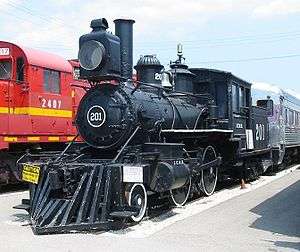

Some historic equipment owned and used by Illinois Central can be found in museums across the United States, including:
- 201, a 2-4-4 tank locomotive that participated in the "Wheels A-Rolling" pageant at the Chicago Railroad Fair. Preserved on static display at Illinois Railway Museum.
- 764, a 651 class 2-8-0 donated to the Museum of Transportation, St. Louis, Missouri in 1956.
- 790. Preserved on static display at Steamtown National Historic Site, believed to be in good condition that restoration to operations is feasible.[2]
- 2500. A 2500 class 4-8-2 preserved on static display in the Age of Steam Memorial in Centralia, Illinois.
- 2542. A 2500 class 4-8-2 preserved on static display at McComb, Mississippi.
- A yard office and unique coal-fueling tower remain at the Illinois Central yards in Council Bluffs, Iowa.
- IC 8408 GP10 locomotive/IC 9426 caboose static display Homewood, IL
- IC-333, a 0-6-0 steam engine, and several passenger cars are on display just outside the historic Yazoo and Mississippi Valley Railroad Company Depot in Baton Rouge, Louisiana.
- I.C.R.R. 1518 Mikado [2-8-2] steam locomotive in Riverfront Park, Paducah, Kentucky
- Illinois Central GP11 #8701, along with an IC caboose, preserved on static display at the Carbondale passenger station in Carbondale, Illinois.
- Illinois Central GP11 #8733 preserved at the Monticello Railway Museum in Monticello, Illinois.
- An Illinois Central caboose and banana car are preserved at the Casey Jones Railroad Museum in Water Valley, Mississippi.
- An Illinois Central caboose is privately owned and preserved in Raymond, Mississippi at the old train depot in the center of the town.
- IC combine #892, IC Day Coaches 2920 2855 2612, IC Business Car #7, IC 10-6 sleeper #3531 "Council Bluffs", IC Dorm-baggage #1906, IC #518 (MAIL STORAGE),IC Panama Limited Observation "Gulfport", ICG cement hopper #100040, IC #65018, IC bridge crane #X238,IC #X1957 Boxcar, IC #X2000 Idler Flat, IC #'s X4342 and X4352 tenders, IC X9151 Jordan Spreader, and IC cabooses 9926 9831 9880. All of which are restored and displayed at the Monticello Railway Museum in Monticello Illinois.
- Illinois Central SD40-2 #6071 (Ex-Gulf, Mobile and Ohio) at the Monticello Railway Museum in Monticello, Illinois
- Illinois Central Gulf GP8 #7738 at the Bluegrass Railroad Museum in Versailles Kentucky
- Illinois Central 9852, a 1941 caboose on display at the Martin & Sue King Railroad Heritage Museum in Cleveland, Mississippi
- 1974 Illinois Central caboose at the French Lick Scenic Railway in French Lick, Indiana.
- Illinois Central caboose on historic main street in Palestine, Illinois.
Mississippi Central (1852–1878)
The original Mississippi Central line was chartered in 1852. Construction of the 255 miles (410 km) 5 ft (1,524 mm)[9] gauge line began in 1853 and was completed in 1860, just prior to the Civil War, from Canton, Mississippi to Jackson, Tennessee.[10] The southern terminus of the line connected to the New Orleans, Jackson and Great Northern Railroad at Canton. It also connected to the Memphis and Charleston Railroad at Grand Junction, Tennessee and the Mobile and Ohio Railroad at Jackson, Tennessee. The Mississippi Central was the scene of several military actions from 1862–1863 and was severely damaged during the fighting.[11] Company president, Absolom M. West succeeded in repairing the damage and returning it to operating condition soon after the end of the War. The original Mississippi Central line was merged into the Illinois Central Railroad subsidiary Chicago, St. Louis and New Orleans Railroad in several transactions finally completed in 1878.[12]
Mississippi Central (1897–1967)
.jpg)
A line started in 1897 as the "Pearl and Leaf Rivers Railroad" was built by the J.J. Newman Lumber Company from Hattiesburg, to Sumrall. In 1904 the name was changed to the Mississippi Central Railroad (reporting mark MSC). In 1906 the Natchez and Eastern Railway was formed to build a rail line from Natchez to Brookhaven. In 1909 this line was absorbed by the Mississippi Central.
For a short time during the 1920s, the line operated a service named "The Natchez Route", running trains from Natchez to Mobile, Alabama through trackage agreements with the Gulf, Mobile and Northern Railroad. At Natchez, freight cars were ferried across the Mississippi River to connect with the Louisiana and Arkansas Railway to institute through traffic into Shreveport, Louisiana. In 1967 the property of the Mississippi Central was sold to the Illinois Central Railroad.[13]
See also
- David L. Gunn
- Harry D. Wilson
- Tammany Trace Rail Trail
- Billups Neon Crossing Signal A unique railroad crossing signal erected in Grenada, MS
References
- ↑ Illinois Central Corporation 1996 Annual Report. Illinois Central Railroad. 1997.
- 1 2 Steamtown National Historic Site, Illinois Central Railroad number 790. Retrieved February 10, 2006.
- ↑ "Amtrak-Illinois dot feasibility study determines most direct route best for service to Rockford, northwestern Illinois and Dubuque, Iowa" (PDF). Amtrak. May 16, 2007. Retrieved 2008-05-02.
- ↑ "Amtrak Black Hawk Service Restoration Status Updates". April 7, 2011. Retrieved 2011-04-07.
- ↑ Ackerman, William K., Railroad Historical Company, Illinois Central Railroad Company. History of the Illinois Central Railroad Company and Representative Employes By William K. Ackerman, Railroad Historical Company, Illinois Central Railroad Company. Retrieved 9 February 2009.
- ↑ Stover, John F., Purdue University. "The Management of the Illinois Central Railroad in the 20th Century" (pdf). Retrieved 9 February 2006.
- ↑ Downey, Clifford J. (2007). Chicago and the Illinois Central Railroad. Images of rail. Charleston, SC: Arcadia Publishing. p. 10. ISBN 0738550744. OCLC 169870743.
- ↑ "Harrison succeeds Ed Moyers at IC". Railway Age. 194 (3): 14. March 1993.
- ↑ Confederate Railroads - Mississippi Central
- ↑ Confederate Railroads – History, Maps & Equipment
- ↑ The Mississippi Central Railroad Campaign
- ↑ IC History
- ↑ Moody's Transportation Manual (1975), p. xxx
- Stover, John F., Purdue University, The Management of the Illinois Central Railroad in the 20th Century (PDF). Retrieved February 9, 2006.
- University of Illinois at Urbana-Champaign Archives, Wayne A. Johnston Papers, 1945–1967. Retrieved February 9, 2006.
External links
| Wikimedia Commons has media related to Illinois Central Railroad. |
- Illinois Central Historical Society
- Illinois Central Railroad On-Line
- Illinois Central Resource Page
- The Illinois Central Railroad, "Main Line of Mid-America"
- STB decision, docket number FD_33556_0 (granting CN control of the IC)
- Illinois Central Railroad Company Archives at the Newberry Library
- Guide to the Illinois Central Gulf Railroad. Memorabilia, 1857–1971. 5197. Kheel Center for Labor-Management Documentation and Archives, Martin P. Catherwood Library, Cornell University.
- Encyclopedia of Chicago "Illinois Central Railroad".
